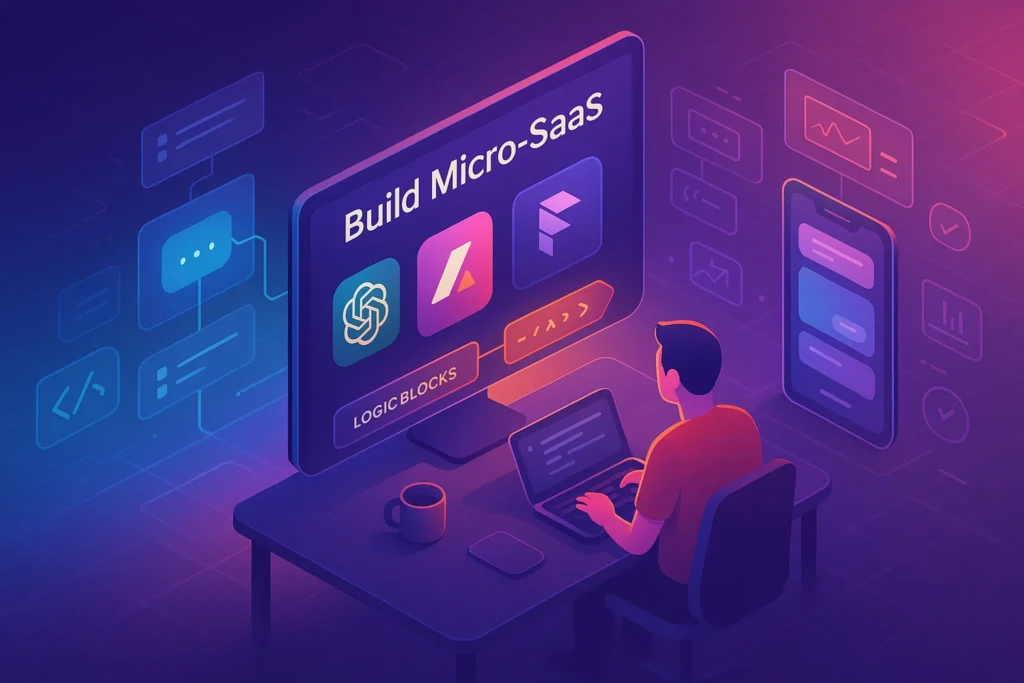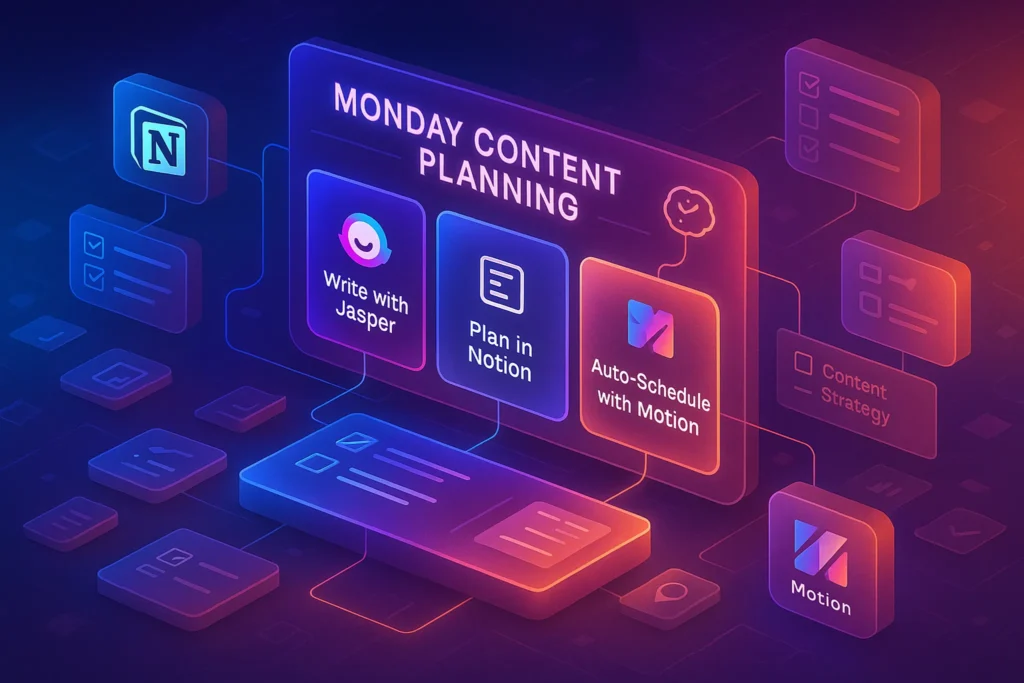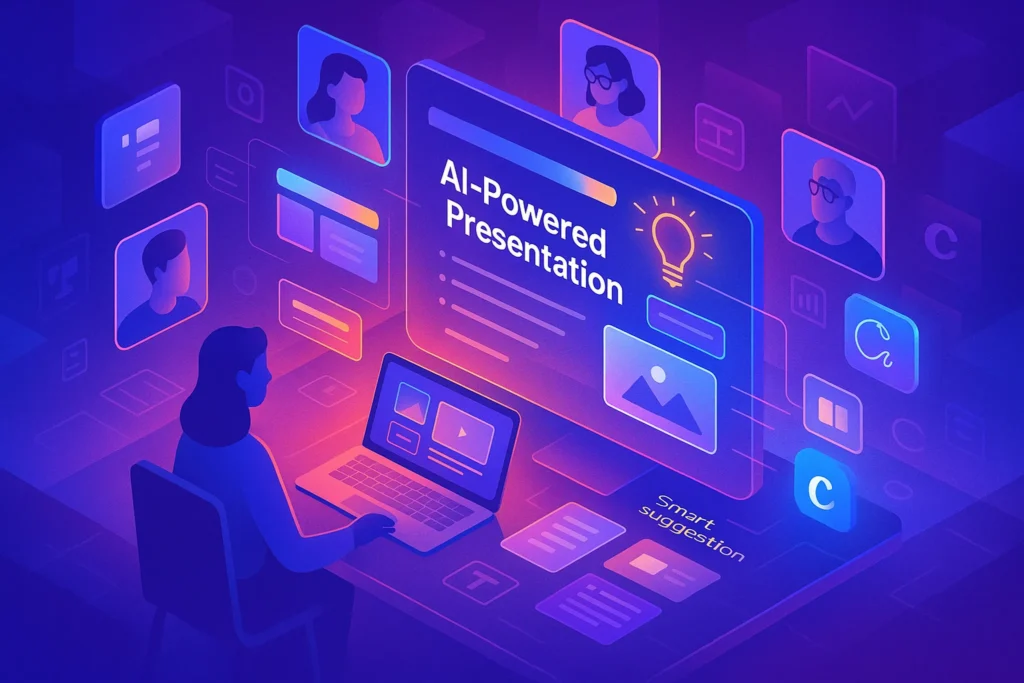-This post may contain affiliate links. If you click on one and make a purchase, I may earn a small commission at no extra cost to you.-
🧠 Introduction – Why Building a Micro‑SaaS with ChatGPT Is a Smart Move (2025)
So you’ve seen AI tools blowing up. Maybe you’ve used ChatGPT, played with a few no-code apps, and now you’re wondering:
Can I actually build a SaaS business—solo—with this stuff?
Short answer? Yes.
We’re entering a golden age for solo founders:
No-code platforms have removed the barrier to entry.
AI tools like ChatGPT do the heavy lifting.
And niche Micro‑SaaS ideas are easier than ever to validate and launch.
But most people get stuck trying to figure out how it all fits together.
This guide breaks it down step by step:
From idea to launch in 30 days — without hiring a dev or learning to code.
👉 By the end of this guide, you’ll be able to plan, build, and publish your own Micro‑SaaS using ChatGPT and no-code tools.
🔧 What You’ll Need to Get Started
Before we dive into the steps, here’s what you’ll need to build your Micro‑SaaS using ChatGPT and no-code tools:
✅ Accounts & Tools:
-
ChatGPT Plus (for access to GPT-4 and custom GPTs)
-
Airtable or Google Sheets (for simple databases)
-
Framer or Webflow (to build your landing page or app UI)
-
Tally or Typeform (to capture user input or feedback)
-
Make (Integromat) or Zapier (to automate workflows)
-
Stripe or Lemon Squeezy (to accept payments)
💡 Optional but useful:
-
Notion – for content delivery, documentation, or MVP output
-
Descript – if your tool includes video/audio processing
-
PhantomBuster – for lead scraping or LinkedIn automation
💬 Need help picking the right stack?
Make sure to check our post:
👉 5 SaaS Tools I’d Use to Build a Business from Scratch
🪩 Step 1: Find a Painful, Narrow Problem to Solve
You’re not building a startup for everyone—you’re solving one specific pain for one specific group.
🎯 Here’s how to find a great problem:
-
Look at your own workflow — what frustrates you daily?
-
Browse Reddit, Indie Hackers, Product Hunt for common complaints
-
Search Twitter for:
“I hate doing…”or“Is there a tool for…”
📌 Tip: The best Micro‑SaaS ideas solve annoying, repetitive tasks—not big, visionary problems.
💡 Examples:
-
“Turn LinkedIn posts into blog drafts”
-
“Summarize YouTube tutorials into Notion checklists”
-
“Automate personalized onboarding emails for course creators”
🔍 Use ChatGPT to help:
Prompt:
“Give me 10 annoying tasks digital marketers do weekly that could be automated with GPT or no-code tools.”
🧠 ChatGPT doesn’t just generate ideas—it helps validate them.
🗺️ Step 2: Define the Outcome and Map the Flow
Once you’ve found a problem, you need to clearly define what your Micro‑SaaS will do and how it will do it.
🔹 Ask these two questions:
-
What does the user get at the end?
(e.g., a PDF report, a Notion page, an email, a list of ideas) -
What are the steps to get there?
(e.g., user input → GPT generates → file exported → sent via email)
📋 Example Flow:
Let’s say you’re building:
“An onboarding email generator for online courses”
Workflow might look like this:
-
User submits course info (via Tally)
-
GPT generates 3-part email sequence
-
Output gets formatted in Notion or Google Docs
-
User gets a download link or email
🧠 Use a tool like Whimsical, Notion, or just pen & paper to sketch your user flow visually.
🛠️ Recommended Tool:
Make.com – perfect for connecting forms, GPT prompts, and delivery steps (has free plan)
🧪 Step 3: Prototype the Flow Using ChatGPT + No-Code
You don’t need a fully built SaaS app yet—you just need to prove the output works and people want it.
🔹 Start with ChatGPT:
Use the custom instructions feature or GPT Builder to design the flow manually.
Prompt:
“You’re a SaaS onboarding expert. When I give you a course topic and description, generate a 3-email welcome series.”
Test it with 3–5 variations. If the results are good, it’s ready for automation.
🔧 Add No-Code Flow:
Use Make.com or Zapier to chain the process:
-
Trigger: Tally form submission
-
Action: Send user input to OpenAI
-
Formatter: Clean up the output
-
Output: Send via email or create Notion doc
🧠 No-code makes your prototype act like a product, even before you build one.
📎 Pro Tip: Use tools like Typeform or Tally with hidden fields to pass structured prompts directly into GPT.
🖥️ Step 4: Build the Landing Page and Waitlist
You have a working flow. Now it’s time to see if real people care.
Don’t wait until it’s perfect—just ship a one-pager that explains:
-
What your tool does
-
Who it helps
-
What the output looks like
🔧 Recommended Tools:
-
Framer – perfect for fast, slick landing pages (no-code, responsive)
-
Carrd – lightweight, ideal for MVP waitlists
-
Beehiiv – email-first, great for niche tools
📋 What to include:
-
Big, clear headline with outcome
-
Screenshot or demo (even mockup is fine)
-
Short bullet benefits
-
Signup form via Tally, MailerLite, or ConvertKit
-
FAQ + mini CTA: “Join the waitlist”
💡 Don’t overthink design. You’re testing value, not aesthetics.
📸 Example Headline:
“Generate a 3-Email Onboarding Series in Seconds – No Copywriting Needed”
🔁 Step 5: Collect Feedback, Iterate, and Charge
Now that your prototype is live and your waitlist is growing, it’s time to:
-
Manually fulfill the first 10–20 requests
This helps you refine the prompts and fix weak points. -
Ask for feedback on:
-
Output quality
-
Speed
-
Usefulness
-
Anything confusing in the flow
-
-
Tweak your prompt or flow as needed
GPT-generated outputs improve with context, examples, and structured inputs. -
Add a payment step
Use Stripe Payment Link, Gumroad, or Lemon Squeezy to monetize.
💬 Offer:
-
Pay once for 5 outputs
-
Or unlock unlimited for $7/month
🛠️ Affiliate Tool Suggestion:
✅ Lemon Squeezy – Easy, global-friendly payment + license delivery
💡 Pro Tip:
Even if your MVP is manual behind the scenes, if the front-end feels automated, users won’t care.
💡 Real Micro‑SaaS Ideas You Can Build With This Stack
Stuck on idea validation? Here are 3 real Micro‑SaaS ideas you could launch using the exact flow from this guide:
1. Content Repurposer for Podcasters
User uploads podcast audio → GPT summarizes → Output sent as blog post draft in Notion.
-
Tools: Descript + GPT + Notion + Make
-
Monetization: Monthly plan via Lemon Squeezy
-
Audience: Coaches, podcasters, course creators
2. LinkedIn DM Personalizer
User pastes a profile URL → GPT analyzes tone, role, bio → Generates a custom intro DM
-
Tools: PhantomBuster + GPT + Tally
-
Monetization: Credit-based or SaaS sub
-
Audience: Agencies, freelancers, sales teams
3. Email Writer for Cold Outreach
Input: Niche + Product → Output: 3 high-converting email drafts tailored to B2B
-
Tools: ChatGPT + Tally + Airtable + Make
-
Monetization: Freemium + Unlock Premium
-
Audience: SaaS founders, marketers
⚙️ Mini Toolkit for Scaling Later
Once you validate the MVP, here’s how to level up your Micro‑SaaS:
| Task | Tool |
|---|---|
| Analytics | Plausible, Simple Analytics |
| Support | HelpKit, Crisp |
| Email sequences | MailerLite, ConvertKit |
| Paywall control | Lemon Squeezy, Memberstack |
| Upsells | Gumroad, Stripe Checkout |
💡 Start lean. Grow smart.
✅ Conclusion – From Idea to Revenue, No Code Required
You don’t need to be a developer.
You don’t need investors.
You don’t need to overthink.
You just need:
-
A narrow problem
-
A working flow
-
A few no-code tools
-
And ChatGPT to supercharge it
This is how solo founders are launching tiny, profitable businesses in 2025—and you can too.
❓ FAQ – Micro‑SaaS with ChatGPT
Can I build a Micro‑SaaS without any coding?
Yes. With ChatGPT + tools like Make, Tally, and Framer, you can go from idea to income solo.
Do I need to train my own AI model?
No. You can use GPT-4 via OpenAI or Claude via API—no training needed.
How fast can I launch?
If you validate early and use no-code, 10–30 days is realistic for an MVP.
💬 Would You Bite?
What idea are you thinking of launching as a Micro‑SaaS?
Drop your concept or ask for help with the stack in the comments! 👇



